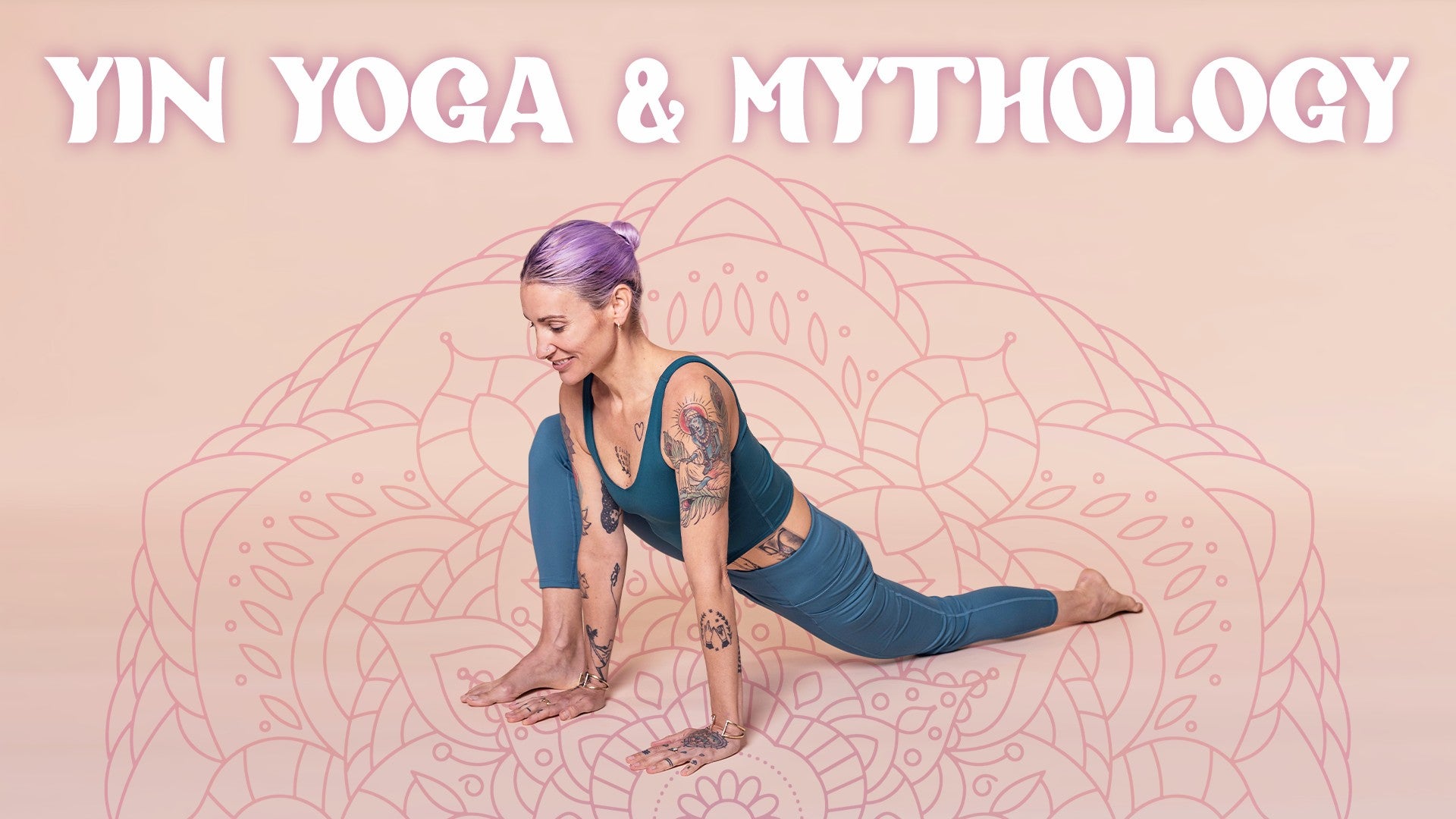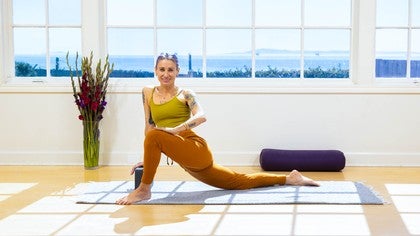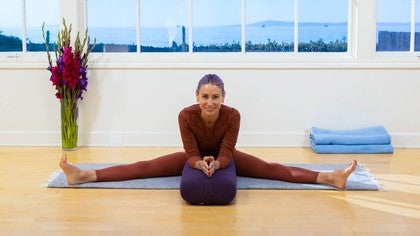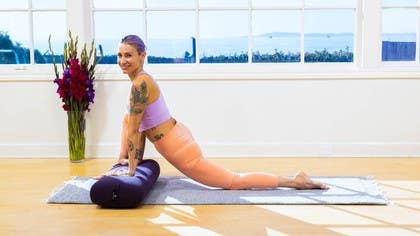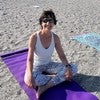Description
About This Video
Transcript
Read Full Transcript
Welcome, Kelly Cam here with another yin yoga and mythology practice for you. This one inspired by the god of destruction, Shiva. I love Shiva so much because he's a god of contradictions, just like many of us are. Very interesting in that he's very passionate and wild. And then on the other hand, he's also very meditative and very calm.
And so we'll explore how those contradictions can sometimes live in us as well. But to get started, just finding a simple seat. You can sit cross-legged. If it's more comfortable for you to sit on a blanket or a block or a pillow, you can always do that. And as you sit, you can let your hands rest anywhere on your body, on your thighs or knees.
Sometimes it's even helpful to place them on your heart or belly. So finding a place to rest, that feels pretty easy and organic. You might let your eyes close or maybe just dim them about halfway shut. And then as you breathe, breathing in and trying to touch the breath all the way down to the very bottom of you, whatever that feels like for you, bringing the breath in all the way down to the bottom of the container. And each time you exhale, a letting go.
And the letting go could happen anywhere. Might be in the face, might be in the belly, might be in the legs. Breathing in, touching deeply down. And breathing out something somewhere. Let's go.
Breathing in, you might bring the breath to the base of your spine, to your roots, to your legs, to your feet. And as you exhale, inviting anything that feels ready to soften, to loosen, to let go. A couple more breaths like this. Inhale, touch down. Exhale, soften.
So Shiva would sit like this, high up in the mountains and meditate for long periods of time. Because he would sit so still, it would rain on him. Rain would turn into snow, the snow would turn into rain again, the sun would beat down on him and through it all, Shiva just sat, sat like a mountain undisturbed by any of the drama around him. So we'll try today to cultivate that sense in ourselves, a sense of stillness, that nobody, that nothing can take away from us, that even in the midst of action, movement and change, we can still touch that place inside of ourselves. That's quiet and peaceful.
So we'll begin today with a simple side bend, which you can use a bolster for or not. I'll show you both ways. So the simple way without props is just to walk your left hand over a little ways from the body, and then the right arm is going to reach up. But for those of you who want to use some support, you can put the pillow or bolster beside you, and either your palm or your elbow and forearm can lean on the bolster. I'm going to lean my arm on the bolster and then take the opposite arm up, and to begin with just a little bit of movement, just going to dance the arm through space a little bit.
I'm making a figure eight, feeling the arm turn in and turn out, you know, but if other shapes want to happen, you could do like a big lasso swing, anything at all, just inviting some space into the shoulder, into the neck, perhaps finding a little loosening through the jaw, teeth, tongue. And then eventually we're going to settle here. And so as you settle, you can either settle with your arm extended overhead, but with the softness, you can even bend the elbow and let it drip. Or the other option is to wrap the top arm behind your back, and not reaching for anything in particular, not trying too hard, but just finding a really soft place to land that feels pretty natural. And then last bit here is the head.
Lots of things you could do, you can let the ear fall towards your shoulder, you could turn your nose down, or you could even keep the head lifted if that's more comfortable for you. I'm going to let my left ear drop to the left shoulder, and just really feeling into the heaviness of the head, and that big opening through the right side of the neck, around the right shoulder, even into the upper back on the right side. And as you settle into your side bend, you could come back to that breathing, breathing in and touching down, and breathing out, maybe your lower body could get a little heavier, a little softer, really planting yourself here, as if you could be unmoved by any storm, by wind, by rain, by snow, you just like the most dignified mountain. There's a Chinese proverb that says, as the wind blows, the mountain remains still. Breathing in, touching the bottom, breathing out, something, somehow, somewhere, softens.
In particular, in this shape, noticing the lower body, the feet, is there any tension in the feet, the ankles, all the way up the legs. And feeling that sense of rooting, anchoring through the lower body, start to very gently write your spine, coming back up, and definitely not rushing through this as you let this pose go, just coming to a really simple seat, hands can rest on your thighs, or anywhere that they're comfortable, and relishing the release of the pose, I find, especially in a side bend, that sometimes coming out of the pose is just as wonderful and interesting as being in it, imagining all the energy being redistributed throughout your whole body as you sit like a mountain, undisturbed. And you really want to wait until the last pose feels like a memory, and when it feels like it's been cleared from your body, then you can move on to the other side, so I'm going to take the bolster and switch it over to the other side, and I'm going to change the cross of my legs, just because why not, even things out, and then heading into that same shape on the other side, so I'm going to walk my hand over and place the forearm down, and then this time it's the left arm that's coming up into the sky like a wild bird, doing a little bit of a dance, drawing a figure eight or any other shapes. You could write somebody's name, someone that you love, write their name in the sky so they're with you for this practice, turning in, turning out the arm, and then finally letting it settle, choosing either arm, draping like a soft umbrella over your head, or wrapping it in a very gentle way behind your back, and deciding where to rest your head, and you know, you can always change your mind, it's perfectly legal to change your mind here, but just settling into one place, and then letting muscles loosen from bones, breathing right into your bone marrow, letting the bones be heavy, and so Shiva, Shiva's beloved is the goddess Parvati, and they have a little family, they have some children, one of them being Ganesh, who you might have heard of, and Shiva loves his family, he adores Parvati, loves his family and his life, and sometimes he needs to go to the mountains to meditate, to get away from it all, and I feel that with Shiva, I can relate to that, I imagine many of you can too, that sometimes it might feel like there's two people, or many people inside of us, that we crave stability, dependability, but also adventure, novelty. Could you feel the weight of your head, and really let it go, let the jaw loosen, maybe so much, that you feel that lower jaw slide down a little bit more, let gravity take it.
Let it go, let it go, let it go. Breathing in, touching deeply down, breathing out, anything, let's go, anything, anywhere, let it go. And a slow return, a very mindful and gentle return to a vertical spine, where you can find your seated mountain shape here, and just paying attention to what you feel inside your own body, any vibration, any buzzing, humming, any warmth or coolness. When you feel pretty quiet again, when your waters have cleared, and your body has settled, we can slowly shift and take our next shape, which is the sphinx. We'll do a little combo here, a sphinx, and if you want to, also a seal pose.
So for this one, you come down onto the belly, and gonna offer a couple of options with the bolster here. One is that you could put it on top of your forearms, it provides a nice place for your forehead to rest. The other option for today is if you feel inspired to, you could also bring the bolster underneath your forearms. That's gonna give you a little more sensation, so it's really up to you if you want more or less, but remembering that we're not here sensation hunting, we're not here to go to our deepest, most extreme shape, that we want it to be a perfect balance between ease and sensation, that we want to feel something, but not too much. So Shiva, Shiva, this god of destruction and god of contradictions, he's a lot like us, torn between novelty and mystery, but also stability and safety, craving adventure and meeting an anchor, wanting to be in the world, but also wanting to transcend.
All of these things can live together in us, as Walt Whitman said, I contain multitudes. So you're welcome to stay in sphinx. The other option, as you could come into seal, I'll show you that, for seal, you're bringing your palms to the floor, slightly turned out, slightly wider than the shoulders, you can walk them as close or as far away as it works for you, and you kind of stake your arms down and then let your spine drape. And this is a pretty big backbend, so you're very welcome to come back down to sphinx at any point, okay? So I'm going to stay in sphinx with my elbows on the bolster for the last couple of minutes here.
And so if you shifted your pose at all, you could just settle again, let your bones settle, let your muscles loosen. And a feeling perhaps here that we could cultivate is just a feeling of really spreading out, making space so that we've got room for all the complex emotions that we feel as a human being, for all of our contradictions, yes, sometimes I want stability and sometimes I just want to get away and have a great adventure, and that's okay. We don't have to repress one part of ourselves or the other. We can be all those things. Check in with your seat and your lower body, imagining any tension just draining away into the floor, your legs just like water.
The wind blows, but the mountain is quiet. At any point, you could bring back that first breathing practice, it's really helpful to cultivate a feeling of being really steady and calm. So breathing in, touching bottom, and breathing out, something softens anything at all. Okay, thank you. We'll come out of this, if you had a bolster, just push it away, gently lower your body down to the floor. As we rest here, you could make a pillow with your hands to rest your head on, or you could cactus your arms. And then we'll just slide one knee up, give it a little bend, and take it up towards the outside of your hip.
It's a nice relief for the lower back to take this bent knee, prone position, after a big back bend, and just noticing whatever you might feel in your low back or anywhere else. If it feels achy at all, no need to panic. It's actually a good thing. We applied a little bit of positive stress so that our body can bounce back stronger, more resilient. Let's change legs, so stretch that leg back down with the other one, and slide the other knee up and out to the side. If you have your head turned, you could turn it the other direction, and then bringing both legs straight back behind you, so that you can come up onto all fours now. I'm gonna head into a little sequence of dragon poses. So the bolster might be helpful. Again, you could use a bolster or a block. Either way, I'll show you with a block just to mix it up a little bit. So block is coming at the front of the mat. I have it on its medium side, but you can adjust any side that fits. I'm gonna bring the right foot forward. It's about to the edge of the mat or so, so that you've got room inside your right foot to bring your hands down, the back knees on the floor, and I've got my block on the medium side and my hands resting on it. You could use a pillow or, like always, no props is just fine too. But often it's helpful to have a little bit of a lift under the hands. And so settling into this dragon, we'll do a few variations on the dragon. And as you settle in, it's a good place to become more spacious, especially if you feel some deep sensation around the hips. To just make room for it, imagine yourself spreading out in all directions. And if you feel really strong sensation, you could imagine that spreading out too, that there's room for it. We'll do a little bit of a wandering dragon here. So you can take your block or your pillow if you're using it or not. I'm gonna move my block over to the left a little bit more, even beyond the edge of the mat, so that my body bends, my spine bends a little bit into a side bend, a lateral stretch. If this becomes too intense at any point, you can go back to where we were with the simple dragon. Otherwise we'll stay out here on the diagonal for a little bit. And just checking in again with the hips, with the legs. Where am I clenching? Where am I resisting? Can I soften? And even in the midst, in the midst of everything, in the midst of great change, in the midst of uncertainty, in the midst of strong winds, can I be calm like a mountain? Can I touch that place inside myself? That's always still and peaceful. We'll take one last dragon here. So this is a twisting dragon. Gonna bring the support back in. This time the block comes under my left hand, which is just about under my shoulder. And then the right hand can do a few different things. I like to bring it to the right knee, turn the right toes out a little bit, and use that right hand to put just a little gentle pressure on the knee to open that right leg out like a wing to the side. You could do that if you're inspired to reach the arm up. That's another way to work this one. I'm gonna keep my hand on my leg, and just a little twist looking over the back shoulder with the head, and settling in once again, breathing in, touching down, breathing out, something softening. So Shiva likes to hang out in the cremation grounds, which might seem like a not so fun place to hang out, but he loves it. Because it's a reminder of life's impermanence. So just a few more breaths here, because everything is impermanent, even the shape. Very impermanent. We'll bring it back, and we'll just take a little rest in between in a child's pose. Go so slow. Those dragons are big poses, so really take your time coming out of it. It can bring your right leg back to meet your left leg. Any variation of a child's pose or anything else your body might crave. I'm going to move the block off to the side so I can put my arms in front of me. So Shiva hangs out with the ghosts and the ghouls. He loves people who live on the fringes. He's a friend of the marginalize, the downtrodden, and he really embraces the impermanence of life, because that's kind of what makes it beautiful in a way. So when you feel rested enough, we'll take the other side of those dragons, bringing your prop back in front of you if you're using it. This time we'll step the left foot up to the left edge of the mat in the front. Right knee is on the ground. I'm bringing my hands to the block, which is on its medium side, and finding a place to live, finding a place to settle, coming down home to your bones. Shiva's job as a god of destruction is to destroy the universe in order to recreate it, to pave the way for progress, to pave the way for positive change. Can we get so comfortable with things falling apart that like Shiva, we can smile through it, this god who's so wild and strong and passionate, but who sits so austere, so calm, face so soft and sweet and meditative. Might we even be able to smile through some of life's big shake-ups and changes? So we'll take it into a little wandering dragon walking the block or the prop over to the right side, or not if you're using your hands on the ground that works too. And you can play with these dragons, you know, if you want to stay in the center the whole time, you could do that. If you want to linger in this lateral stretch, you could do that, or you could come on back with me and take the twist. So the block is going to be under my right hand, which is under my shoulder, and then left hand is coming to the left leg, somewhere around the knee, toes can turn out. I'm even rolling under the pinky toe edge of my foot so I can really wing the knee out. And then there's a twist of the spine, perhaps a look over the shoulder, and that touching in, touching down, and settling, and just feeling how in the midst of everything it is possible, it is possible to stay calm. You can remember this place, right? Yin poses are really great teachers because they pattern us. We can remember this when we get into a wild moment in our life, when the the winds pick up, the winds of change in our life. We might remember this moment where it felt difficult, but we could stay calm. And so we'll bring it back, both hands coming down for support, can very gently collect yourself back into child's pose, left leg comes back to meet right leg, just a little moment of dropping down here. And we're actually gonna cross the arms for this version. That's an invitation, it's all an invitation, but I'm gonna reach for opposite elbows and inch the arms out a little bit to let my head drop. If your head might touch the ground, it might not, and that's just fine either way. Coming up a bit, you can switch the arms, so whichever arm was on top, just changing, put the other arm on top, and dropping back down into that child's pose again.
So as we transition to resting, would it be possible to stay so low to the ground, to move as little as possible, to disturb as little as possible, crawling your way over onto your back, then letting everything drop, imagining every molecule of you spreading out and sinking down like you're water pouring yourself into the earth. You can let the next breath in be a little bigger, a little more generous, and the exhale really long and slow. Then a little blink, a little wiggle here and there, just feeling your electromagnetic energy start to wake up, and then staying close to that still place inside you, begin the process of coming back. Anyway you want to get there is good. We can meet, seated once again, seated, calm like the eye of the storm, no matter what's happening in us, around us, in our life. We can remember this place of steadiness and bring our fingertips together, our mudra for this class is called Hakini mudra, and all the fingers touch right at the tips, the inside is open. You can bring that anywhere you like, I'm gonna bring it right in front of my chest and belly area. As you take Hakini mudra, letting your shoulders soften, your face soften, finding that suggestion of stillness. May this mudra inspire us to welcome all parts of ourselves, all the many complex emotions that we feel, to not push anything away, but just make room for all of our contradictions. May we remember this place of steadiness when the winds of change blow. Om Namah Shivaya. Folding the palms together in a prayer, bow your head towards your hands. Thank you so much for joining me in this practice. Until next time, Namaste.
Yin Yoga and Mythology
Comments
Advils; released a lot of morning inflammation, and have always loved that Whitman line... Here is another that relates—"I too am not a bit tamed—I too am untranslatable" My literary mind loved this practice!
You need to be a subscriber to post a comment.
Please Log In or Create an Account to start your free trial.
